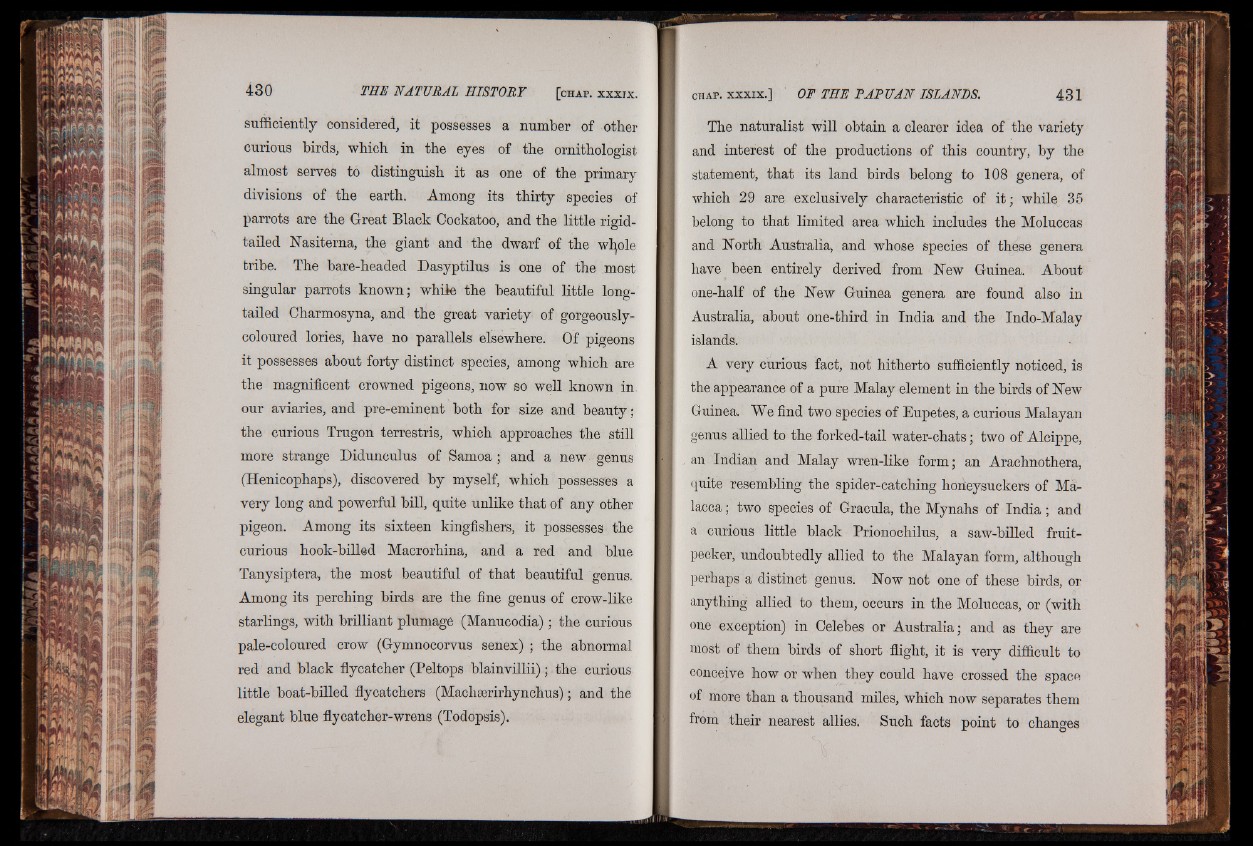
sufficiently considered, it possesses a number of other
curious birds, which in the eyes of the ornithologist
almost serves to distinguish it as one of the primary
divisions of the earth. Among its thirty species of
parrots are the Great Black Cockatoo, and the little rigidtailed
Nasiterna, the giant and the dwarf of the whole
tribe. The bare-headed Dasyptilus is one of the most
singular parrots known; while the beautiful little longtailed
Charmosyna, and the great variety of gorgeously-
coloured lories, have no parallels elsewhere. Of pigeons
it possesses about forty distinct species, among which are
the magnificent crowned pigeons, now so well known in
our aviaries, and pre-eminent both for size and beauty;
the curious Trugon terrestris, which approaches the still
more strange Didunculus of Samoa ; and a new genus
(Henicophaps), discovered by myself, which possesses a
very long and powerful bill, quite unlike that of any other
pigeon. Among its sixteen kingfishers, it possesses the
curious hook-billed Macrorhina, and a red and blue
Tanysiptera, the most beautiful of that beautiful genus.
Among its perching birds are the fine genus of crow-like
starlings, with brilliant plumage (Manucodia); the curious
pale-coloured crow (Gymnocorvus senex) ; the abnormal
red and black flycatcher (Peltops blainvillii); the curious
little boat-billed flycatchers (Machserirhynchus); and the
elegant blue flycatcher-wrens (Todopsis).
The naturalist will obtain a clearer idea of the variety
and interest of the productions of this country, by the
statement, that its land birds belong to 108 genera, of
which 29 are exclusively characteristic of i t ; while 35
belong to that limited area which includes the Moluccas
and North Australia, and whose species of these genera
have been entirely derived from New Guinea. About
one-half of the New Guinea genera are found also in
Australia, about one-third in India and the Indo-Malay
islands.
A very curious fact, not hitherto sufficiently noticed, is
the appearance of a pure Malay element in the birds of New
Guinea. We find two species of Eupetes, a curious Malayan
genus allied to the forked-tail water-chats; two of Alcippe,
an Indian and Malay wren-like form; an Arachnothera,
quite resembling the spider-catching horieysuckers of Malacca;
two species of Gracula, the Mynahs of India; and
a curious little black Prionochilus, a saw-billed fruit-
pecker, undoubtedly allied to the Malayan form, although
perhaps a distinct genus. Now not one of these birds, or
anything allied to them, occurs in the Moluccas, or (with
one exception) in Celebes or Australia; and as they are
most of them birds of short flight, it is very difficult to
conceive how or when they could have crossed the space
of more than a thousand miles, which now separates them
from their nearest allies. Such facts point to changes